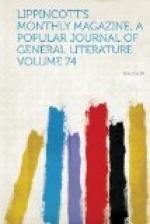About ten o’clock we stopped at Colonel Bullock’s ranch. Not a soul within: all hands were gone off to a “rounding out,” or branding of cattle—a wild scene, they say, and worth seeing. The herders, rough men with shaggy hair and wild, staring eyes, in butternut trousers stuffed into great rough boots, drive the cattle together, a mass of tossing horns and hoofs, and brand the names of their several owners upon them—a work full of excitement and not unattended with peril. We looked curiously about the ranch, which resembled others we had seen: a log house, furnished with the necessaries of life, with buffalo skins and arms in plenty lying about, and some hanging shelves, containing a number of very good books, including a classical dictionary. About the middle of the day we rested a few minutes at Owen’s Ranch, where lived a handsome blond young man with a nice white wife. His corral was surrounded with a wall of neat masonry, instead of the usual crooked posts. Here were Chug Springs, the head of a branch stream, and from thence we went over what we were told was the toughest divide in the whole country. The heat was scorching over the dreary, dusty wastes of sand and alkali, where hardly the cactus could find sustenance. This was our first glimpse of the Mauvaises Terres, the alkali-lands, which turn up their white linings here and there, but do not quite prevail on this side the Platte. The Black Hills of Wyoming, with their dark jagged outlines, gave life to the backward view, and when they were concealed Laramie Peak appeared on the left—a mountain of noble form and color. At Eagle’s Nest the yellow bluffs again started up, opening with a striking gateway, through which a fine picture of the blue peak showed itself down a dry valley, a chimney rock in the foreground giving emphasis to the view. The bluffs disappeared, and there was again the desert, and always the desert, with its heat and dust. Our four shining black mules went bravely on, however, and at five o’clock we came in sight of Fort Laramie, a little brown spot far away over the plain. In less than an hour we arrived at the post in a whirlwind of dust.
We were expected, for had we not followed the telegraph-wires? Utter strangers as we were, at once we were made to feel at home, and everything was done for the comfort of the weary travelers. A description of this fort will do for all the rest, though this is one of the oldest, largest and most important posts. There is no sort of fortification whatever: a large parade-ground, nearly destitute of grass and planted with half-dead trees, is surrounded by the barracks and quarters, neat, low buildings, and beyond, at one end, are the ordnance and sutler’s stores. A hospital and a large old barrack called Bedlam tower above the rest: more buildings straggle away toward the Laramie River, where there is a bridge. The position commands the river and bluffs. No grass, no gardens, no irrigation, no vegetables nor




